Exergo-Ecological Assessment of Waste to Energy Plants Supported by Solar Energy
Abstract
1. Introduction
2. Materials and Methods
2.1. Modeling Approach
2.2. Description and Characteristic of the System
2.3. Thermoeconomic and Thermoecological Analysis
3. Results Exergy and Thermo-Ecological Analysis
4. Conclusions
Supplementary Materials
Author Contributions
Conflicts of Interest
References
- European Parliament and Council. Directive 2008/98/EC of the European Parliament and of the Council of 19 November 2008 on waste and repealing certain directives. Off. J. Eur. Union 2008, 3–30. Available online: http://www.reach-compliance.eu/english/legislation/docs/launchers/waste/launch-2008-98-EC.html (accessed on 11 March 2018).
- European Commission. Communication from the Commission to the European Parliament, the Council, the European Economic and Social Committee and the Committee of the Regions: The Role of Waste-to-Energy in the Circular Economy COM/2017/0034. 2017. Available online: http://ec.europa.eu/environment/waste/waste-to-energy.pdf (accessed on 11 March 2018).
- Zhang, D.; Huang, G.; Xu, Y.; Gong, Q. Waste-to-energy in China: Key challenges and opportunities. Energies 2015, 8, 14182–14196. [Google Scholar] [CrossRef]
- Reimann, D.O. CEWEP Energy Report III (Status 2007–2010); Confederation of European Waste-to-Energy Plants: Wurzburg, Germany, 2013; pp. 1–35. [Google Scholar]
- Palstra, S.W.L.; Meijer, H.A.J. Carbon-14 based determination of the biogenic fraction of industrial CO2 emissions—Application and validation. Bioresour. Technol. 2010. [Google Scholar] [CrossRef] [PubMed]
- Cardoso, J.; Silva, V.; Eusébio, D.; Brito, P. Hydrodynamic modelling of municipal solid waste residues in a pilot scale fluidized bed reactor. Energies 2017, 10, 1773. [Google Scholar] [CrossRef]
- Eriksson, O.; Finnveden, G. Energy Recovery from Waste Incineration—The Importance of Technology Data and System Boundaries on CO2 Emissions. Energies 2017, 10, 539. [Google Scholar] [CrossRef]
- Rocco, M.V.; Di Lucchio, A.; Colombo, E. Exergy Life Cycle Assessment of electricity production from Waste-to-Energy technology: A Hybrid Input-Output approach. Appl. Energy 2017, 194, 832–844. [Google Scholar] [CrossRef]
- Lee, S.-H.; Themelis, N.J.; Castaldi, M.J. High-Temperature Corrosion in Waste-to-Energy Boilers. J. Therm. Spray Technol. 2007, 16, 104–110. [Google Scholar] [CrossRef]
- Persson, K.; Broström, M.; Carlsson, J.; Nordin, A.; Backman, R. High temperature corrosion in a 65 MW waste to energy plant. Fuel Process. Technol. 2007, 88, 1178–1182. [Google Scholar] [CrossRef]
- Martin, J.J.E.; Koralewska, R.; Wohlleben, A. Advanced solutions in combustion-based WtE technologies. Waste Manag. 2015, 37, 147–156. [Google Scholar] [CrossRef] [PubMed]
- Lombardi, L.; Carnevale, E.; Corti, A. A review of technologies and performances of thermal treatment systems for energy recovery from waste. Waste Manag. 2015, 37, 26–44. [Google Scholar] [CrossRef] [PubMed]
- Consonni, S.; Silva, P. Off-design performance of integrated waste-to-energy, combined cycle plants. Appl. Therm. Eng. 2007, 27, 712–721. [Google Scholar] [CrossRef]
- Cucchiella, F.; D’Adamo, I.; Gastaldi, M. The Economic Feasibility of Residential Energy Storage Combined with PV Panels: The Role of Subsidies in Italy. Energies 2017, 10, 1434. [Google Scholar] [CrossRef]
- Lombardi, L.; Mendecka, B.; Carnevale, E. WtE efficiency improvements: Integration with solar thermal energy. In Proceedings of the 5th International Conference on Sustainable Solid Waste Management, Athens, Greece, 21–24 June 2017. [Google Scholar]
- Wang, L.; Yang, Y.; Morosuk, T.; Tsatsaronis, G. Advanced Thermodynamic Analysis and Evaluation of a Supercritical Power Plant. Energies 2012, 5, 1850–1863. [Google Scholar] [CrossRef]
- Cozzolino, R. Thermodynamic Performance Assessment of a Novel Micro-CCHP System Based on a Low Temperature PEMFC Power Unit and a Half-Effect Li/Br Absorption Chiller. Energies 2018, 11, 315. [Google Scholar] [CrossRef]
- Eboh, F.; Ahlström, P.; Richards, T. Exergy Analysis of Solid Fuel-Fired Heat and Power Plants: A Review. Energies 2017, 10, 165. [Google Scholar] [CrossRef]
- Toro, C.; Rocco, M.; Colombo, E. Exergy and Thermoeconomic Analyses of Central Receiver Concentrated Solar Plants Using Air as Heat Transfer Fluid. Energies 2016, 9, 885. [Google Scholar] [CrossRef]
- Zhu, Y.; Zhai, R.; Peng, H.; Yang, Y. Exergy destruction analysis of solar tower aided coal-fired power generation system using exergy and advanced exergetic methods. Appl. Therm. Eng. 2016, 108, 339–346. [Google Scholar] [CrossRef]
- Peng, S.; Wang, Z.; Hong, H.; Xu, D.; Jin, H. Exergy evaluation of a typical 330 MW solar-hybrid coal-fired power plant in China. Energy Convers. Manag. 2014, 85, 848–855. [Google Scholar] [CrossRef]
- Manente, G.; Rech, S.; Lazzaretto, A. Optimum choice and placement of concentrating solar power technologies in integrated solar combined cycle systems. Renew Energy 2016, 96, 172–189. [Google Scholar] [CrossRef]
- Baghernejad, A.; Yaghoubi, M. Exergy analysis of an integrated solar combined cycle system. Renew. Energy 2010, 35, 2157–2164. [Google Scholar] [CrossRef]
- Mathkor, R.; Agnew, B.; Al-Weshahi, M.; Latrsh, F. Exergetic Analysis of an Integrated Tri-Generation Organic Rankine Cycle. Energies 2015, 8, 8835–8856. [Google Scholar] [CrossRef]
- Bellos, E.; Tzivanidis, C. Optimization of a Solar-Driven Trigeneration System with Nanofluid-Based Parabolic Trough Collectors. Energies 2017, 10, 848. [Google Scholar] [CrossRef]
- Calise, F.; Capuano, D.; Vanoli, L. Dynamic Simulation and Exergo-Economic Optimization of a Hybrid Solar–Geothermal Cogeneration Plant. Energies 2015, 8, 2606–2646. [Google Scholar] [CrossRef]
- Calise, F.; d’Accadia, M.; Piacentino, A.; Vicidomini, M. Thermoeconomic Optimization of a Renewable Polygeneration System Serving a Small Isolated Community. Energies 2015, 8, 995–1024. [Google Scholar] [CrossRef]
- Usón, S.; Kostowski, W.J.; Stanek, W.; Gazda, W. Thermoecological cost of electricity, heat and cold generated in a trigeneration module fuelled with selected fossil and renewable fuels. Energy 2015, 92, 308–319. [Google Scholar] [CrossRef]
- Szargut, J. Exergy Method: Technical and Ecological Applications; WIT Press: Boston, MA, USA, 2005. [Google Scholar]
- Szargut, J.; Zibik, A.; Stanek, W. Depletion of the non-renewable natural exergy resources as a measure of the ecological cost. Energy Convers. Manag. 2002, 43, 1149–1163. [Google Scholar] [CrossRef]
- Lombardi, L.; Mendecka, B.; Carnevale, E. Comparative life cycle assessment of alternative strategies for energy recovery from used cooking oil. J. Environ. Manag. 2017. [Google Scholar] [CrossRef] [PubMed]
- Mendecka, B.; Lombardi, L.; Kozioł, J. Probabilistic multi-criteria analysis for evaluation of biodiesel production technologies from used cooking oil. Renew. Energy 2017. [Google Scholar] [CrossRef]
- Lombardi, L.; Mendecka, B.; Carnevale, E.; Stanek, W. Environmental impacts of electricity production of micro wind turbines with vertical axis. Renew. Energy 2017. [Google Scholar] [CrossRef]
- Czarnowska, L.; Stanek, W.; Pikoń, K.; Nadziakiewicz, J. Environmental quality evaluation of hard coal using LCA and exergo-ecological cost methodology. Chem. Eng. Trans. 2014, 42, 139–144. [Google Scholar] [CrossRef]
- Stanek, W.; Gazda, W.; Kostowski, W. Thermo-ecological assessment of CCHP (combined cold-heat-and-power) plant supported with renewable energy. Energy 2015, 92, 279–289. [Google Scholar] [CrossRef]
- Soares, T.; Silva, M.; Sousa, T.; Morais, H.; Vale, Z. Energy and Reserve under Distributed Energy Resources Management—Day-Ahead, Hour-Ahead and Real-Time. Energies 2017, 10, 1778. [Google Scholar] [CrossRef]
- Morris, D.R.; Szargut, J. Standard chemical exergy of some elements and compounds on the planet earth. Energy 1986, 11, 733–755. [Google Scholar] [CrossRef]
- Omendra, S.C.K.; Singh, K. Estimation of chemical exergy of solid, liquid and gaseous fuels used in thermal power plants. J. Therm. Anal. Calorim. 2013, 115, 903–908. [Google Scholar] [CrossRef]
- Petela, R. Exergy of undiluted thermal radiation. Sol. Energy 2003, 74, 469–488. [Google Scholar] [CrossRef]
- Stanek, W.; Gazda, W. Exergo-ecological evaluation of adsorption chiller system. Energy 2014, 76, 42–48. [Google Scholar] [CrossRef]
- Saidur, R.; BoroumandJazi, G.; Mekhlif, S.; Jameel, M. Exergy analysis of solar energy applications. Renew. Sustain. Energy Rev. 2012, 16, 350–356. [Google Scholar] [CrossRef]
- Stanek, W. (Ed.) Thermodynamics for Sustainable Management of Natural Resources; Springer International Publishing: Cham, Switzerland, 2017. [Google Scholar]
- Almutairi, A.; Pilidis, P.; Al-Mutawa, N. Energetic and Exergetic Analysis of Combined Cycle Power Plant: Part-1 Operation and Performance. Energies 2015, 8, 14118–14135. [Google Scholar] [CrossRef]
- Heijungs, R.; Kleijn, R. Numerical approaches towards life cycle interpretation five examples. Int. J. Life Cycle Assess. 2001, 6, 141–148. [Google Scholar] [CrossRef]
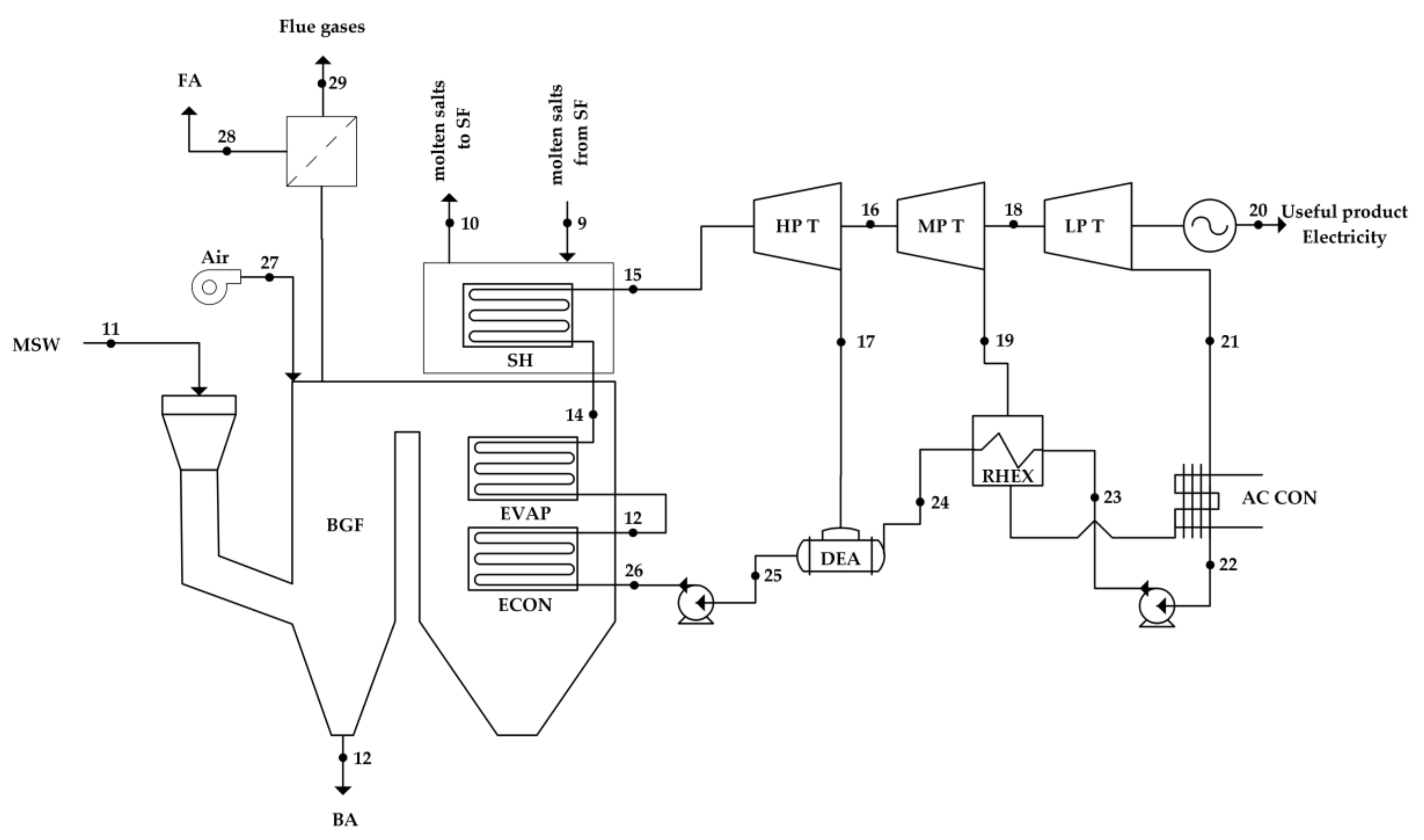
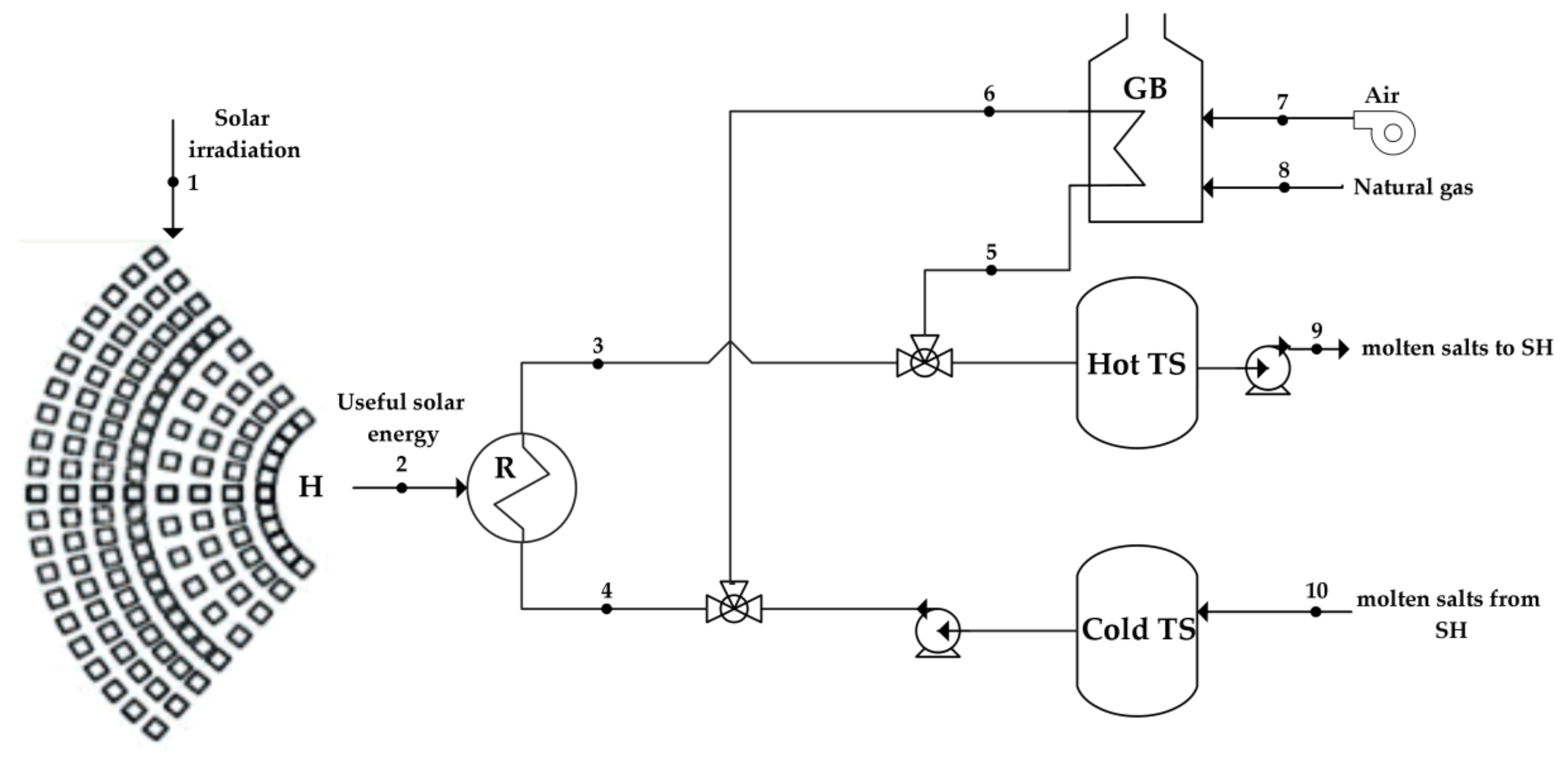

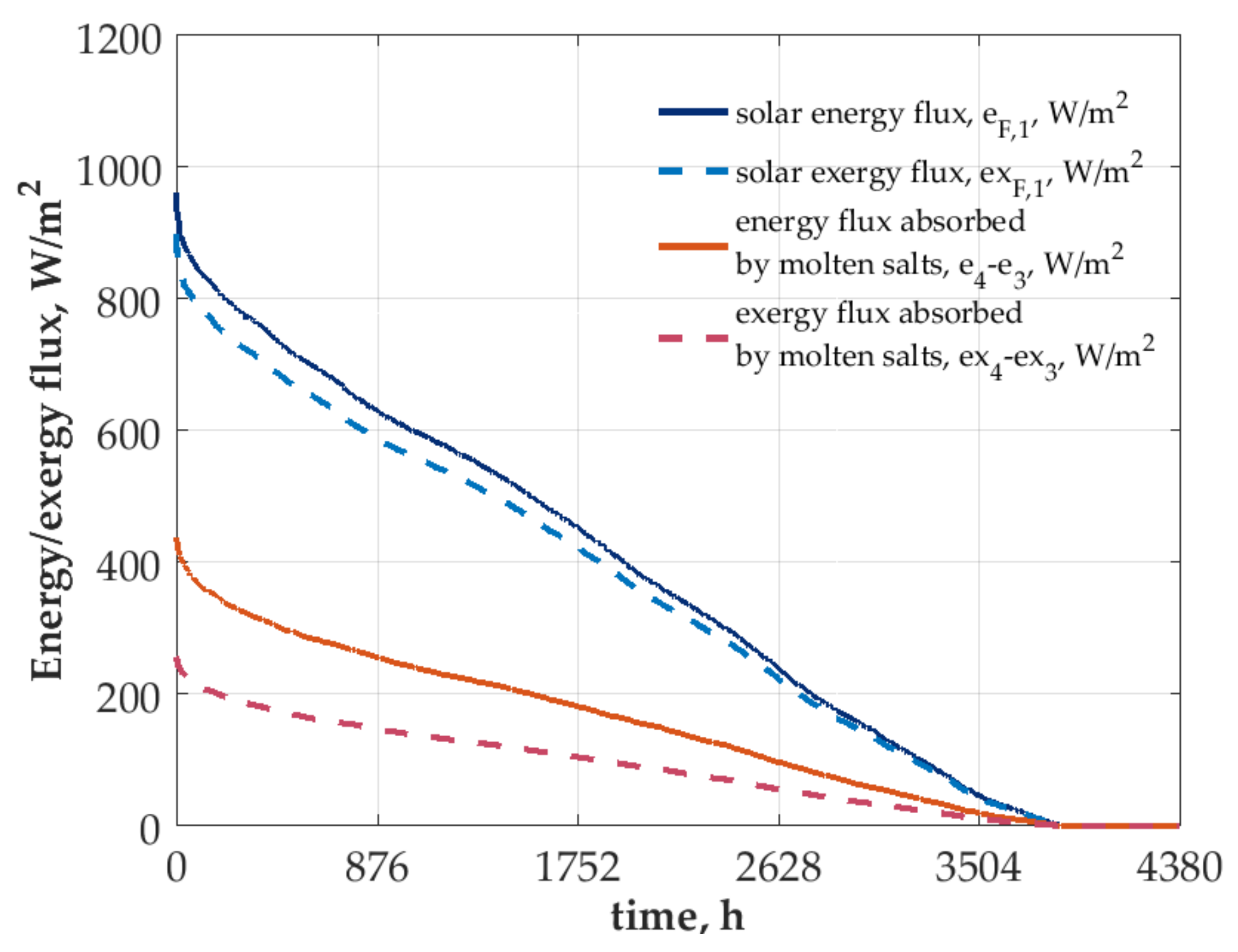
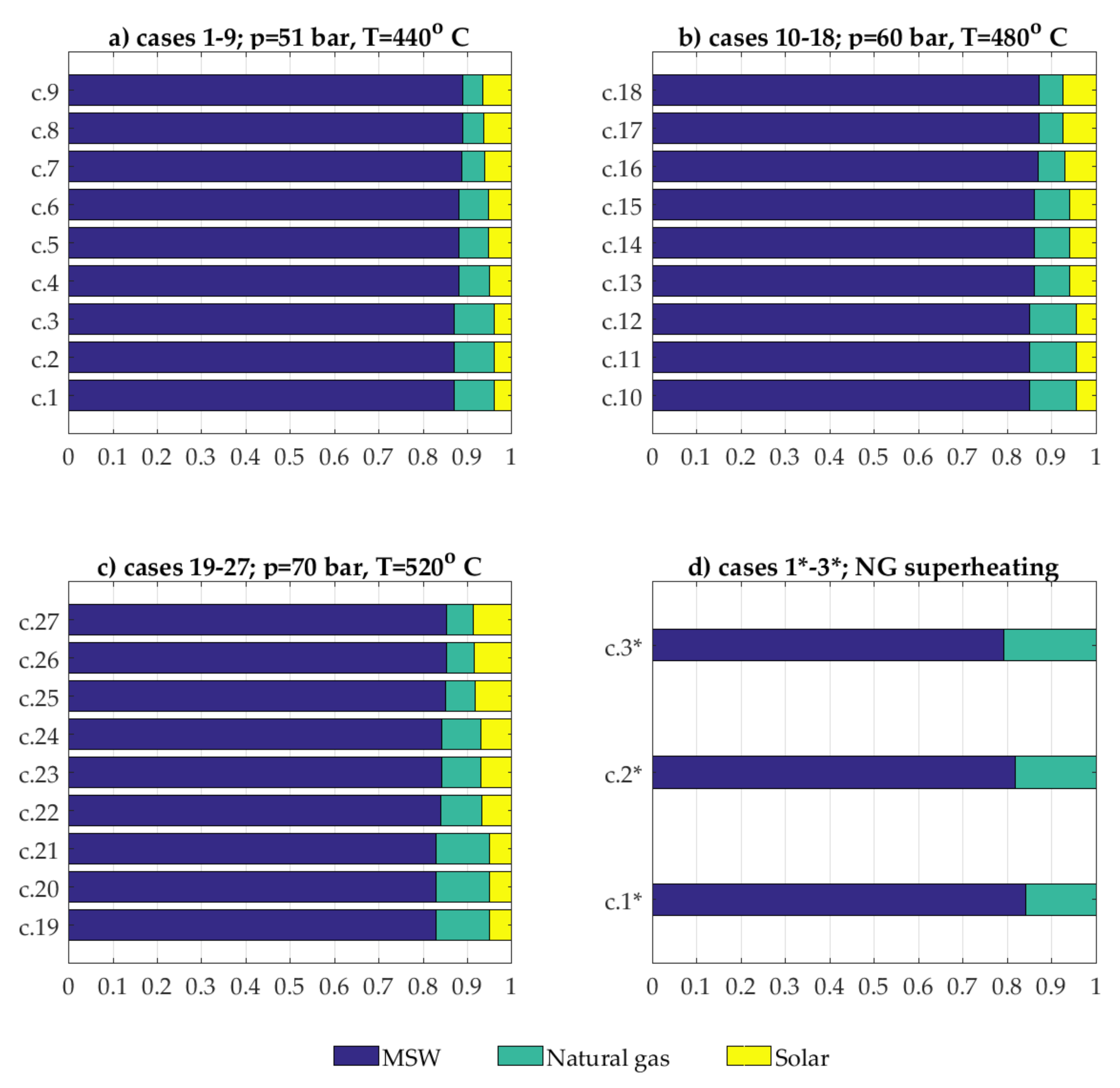
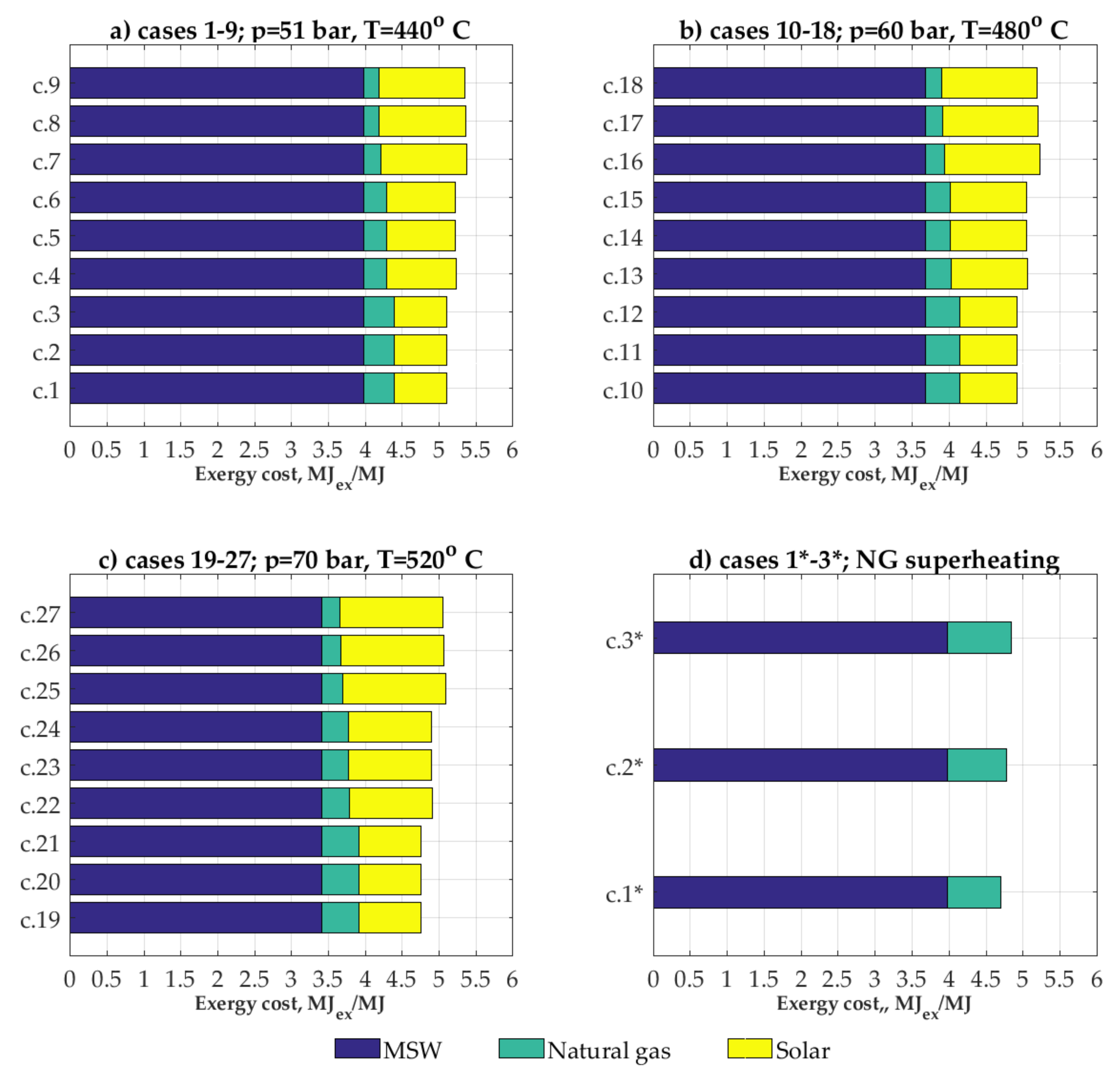
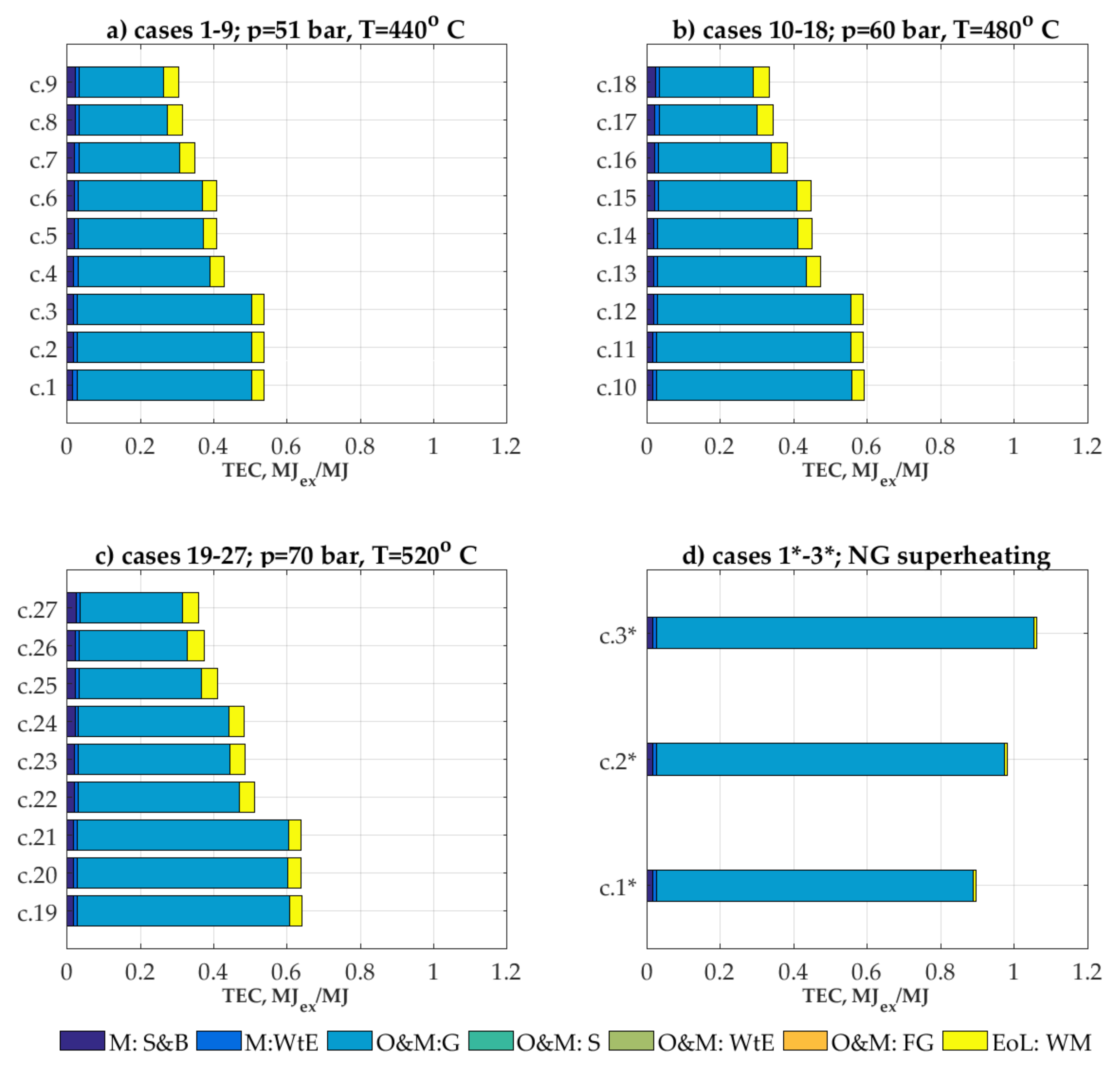
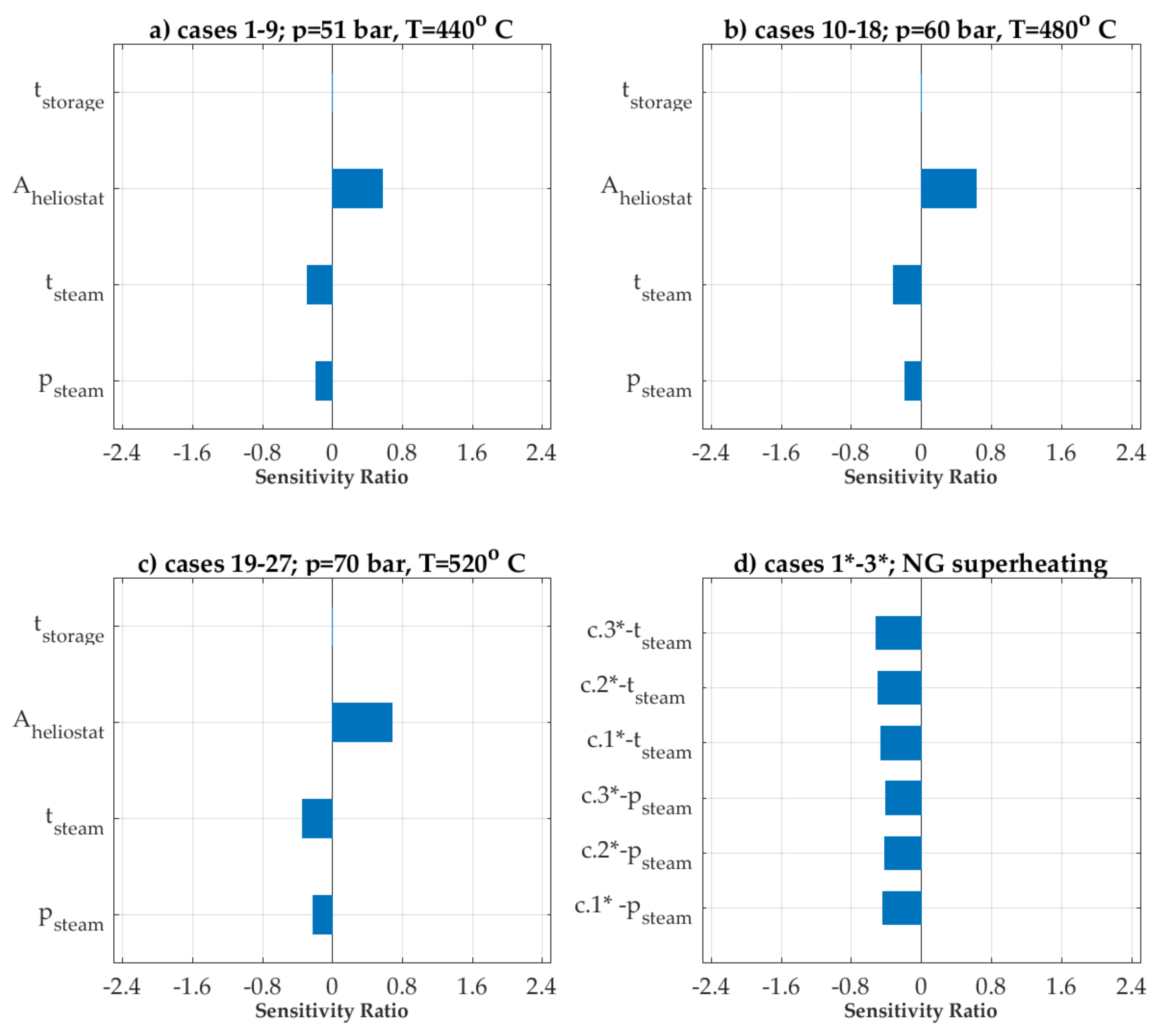
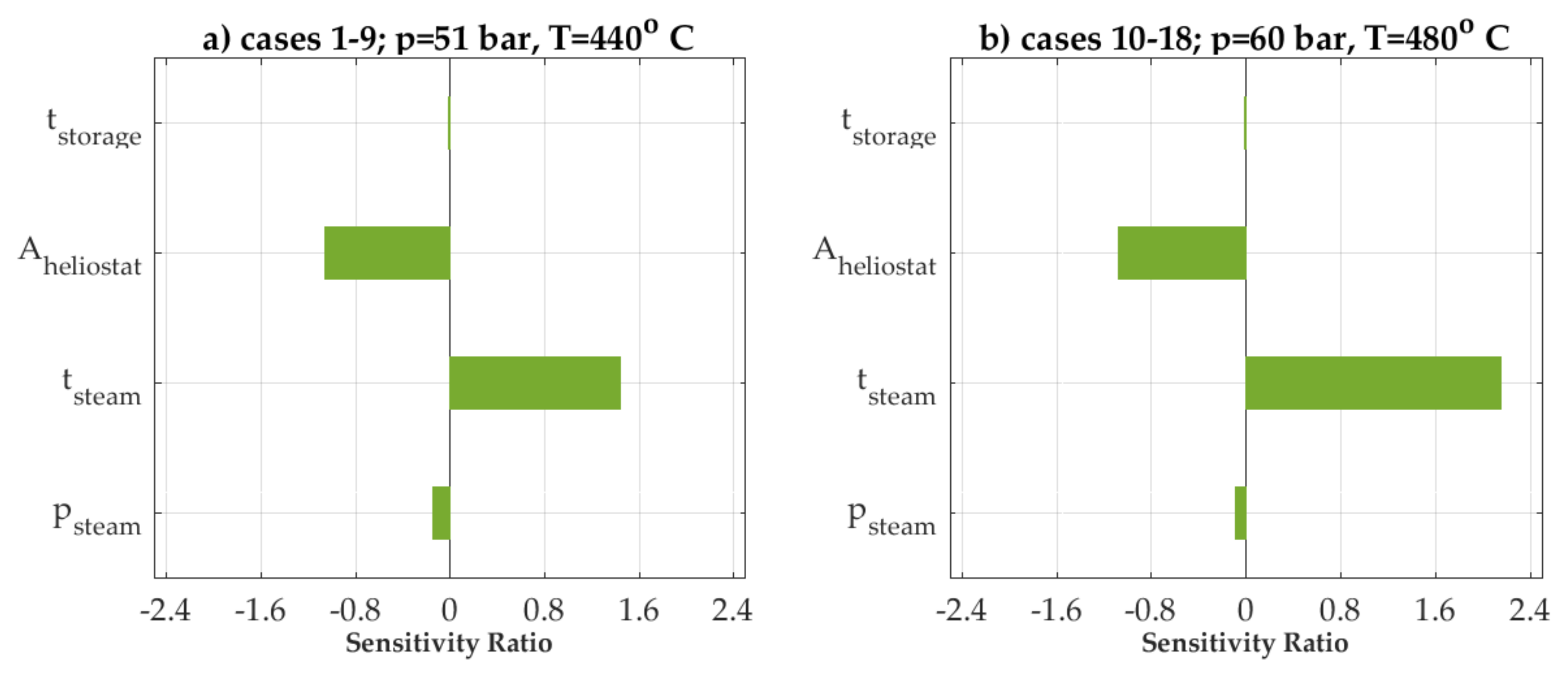
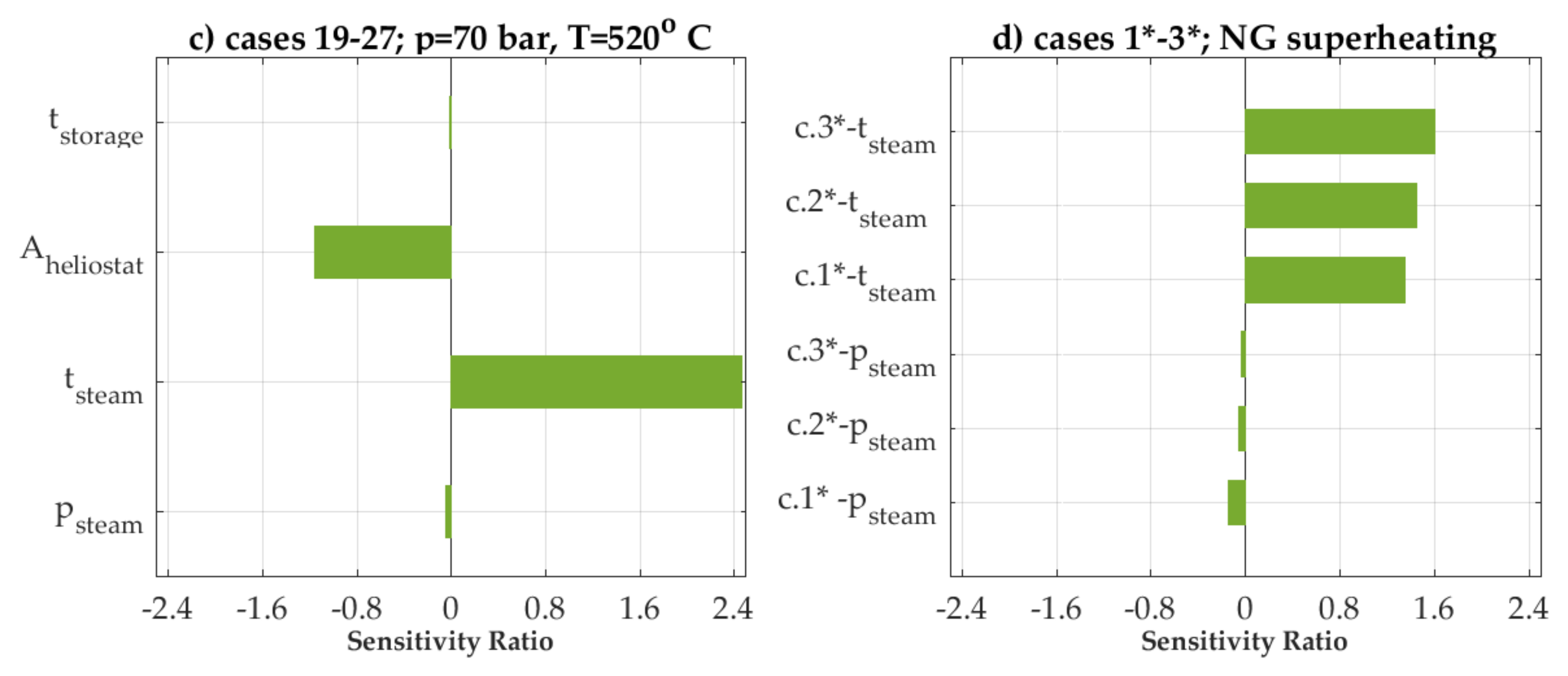
| Case No. | Steam Parameters | Solar Multiple/Time of Storage | Superheating Power | Storage Tank Size | Heliostat Aperture | Net Electricity Output |
|---|---|---|---|---|---|---|
| bar/°C | -/h | MW | m3 | m2 | MWh year−1 | |
| 1 | 51.0/440 | 1.5/6 | 9.8 | 462 | 59,640 | 123,973 |
| 2 | 1.5/10 | 9.8 | 713 | 59,640 | 123,973 | |
| 3 | 1.5/14 | 9.8 | 998 | 59,640 | 123,974 | |
| 4 | 2.0/6 | 9.8 | 571 | 79,440 | 123,998 | |
| 5 | 2.0/10 | 9.8 | 951 | 79,440 | 124,007 | |
| 6 | 2.0/14 | 9.8 | 1331 | 79,440 | 124,008 | |
| 7 | 2.5/6 | 9.8 | 713 | 99,240 | 124,013 | |
| 8 | 2.5/10 | 9.8 | 1189 | 99,240 | 124,026 | |
| 9 | 2.5/14 | 9.8 | 1664 | 99,240 | 124,030 | |
| 10 | 60.0/480 | 1.5/6 | 11.7 | 510 | 70,920 | 133,993 |
| 11 | 1.5/10 | 11.7 | 882 | 70,920 | 133,994 | |
| 12 | 1.5/14 | 11.7 | 1235 | 70,920 | 133,994 | |
| 13 | 2.0/6 | 11.7 | 705 | 94,560 | 134,022 | |
| 14 | 2.0/10 | 11.7 | 1176 | 94,560 | 134,033 | |
| 15 | 2.0/14 | 11.7 | 1646 | 94,560 | 134,035 | |
| 16 | 2.5/6 | 11.7 | 882 | 118,200 | 134,039 | |
| 17 | 2.5/10 | 11.7 | 1470 | 118,200 | 134,057 | |
| 18 | 2.5/14 | 11.7 | 2058 | 118,200 | 134,062 | |
| 19 | 70.0/520 | 1.5/6 | 13.6 | 619 | 83,040 | 144,581 |
| 20 | 1.5/10 | 13.6 | 1073 | 83,040 | 144,582 | |
| 21 | 1.5/14 | 13.6 | 1502 | 83,040 | 144,582 | |
| 22 | 2.0/6 | 13.6 | 858 | 110,640 | 144,616 | |
| 23 | 2.0/10 | 13.6 | 1430 | 110,640 | 144,628 | |
| 24 | 2.0/14 | 13.6 | 2002 | 110,640 | 144,630 | |
| 25 | 2.5/6 | 13.6 | 1073 | 138,360 | 144,636 | |
| 26 | 2.5/10 | 13.6 | 1788 | 138,360 | 144,654 | |
| 27 | 2.5/14 | 13.6 | 2503 | 138,360 | 144,662 | |
| 1* | 51.0/440 | - | 9.8 | - | - | 127,973 |
| 2* | 60.0/480 | - | 11.7 | - | - | 138,504 |
| 3* | 70.0/520 | - | 13.6 | - | - | 149,664 |
| Chemical Composition | Specific Exergy | ||||
|---|---|---|---|---|---|
| kJ kg−1 | - | kJ kg−1 | kJ kg−1 | ||
| Natural gas [volumetric analysis] | CH4: 96.0; C2H6: 1.3; C3H8: 0.2; N2: 2.5 | 47,941 | 1.036 | 49,686 | |
| MSW [ultimate analysis] | C: 27.59; H: 4.23 O: 17.39; S: 0.04; N: 0.67; Cl: 0.26; F: 0.004; Ash: 16.46; H2O: 33.37 | 10,411 | 1.099 | 11,880 |
| Subsystem | Exergy Received | Exergy Loss | Second Law Efficiency | Exergy Cost | ||||
|---|---|---|---|---|---|---|---|---|
| MW | MW | % | MW/MW | |||||
| Case No. | Case 1 | Case 27 | Case 1 | Case 27 | Case 1 | Case 27 | Case 1 | Case 27 |
| Heliostat | 9.945 | 23.059 | 4.840 | 11.1872 | 51.33 | 51.49 | 1.948 | 1.942 |
| Receiver | 5.105 | 11.872 | 2.595 | 6.0391 | 49.17 | 49.13 | 2.034 | 2.035 |
| Tank | 2.511 | 5.837 | 0.003 | 0.170 | 99.92 | 98.31 | 1.001 | 1.017 |
| Backup system | 5.863 | 3.985 | 2.712 | 1.834 | 53.70 | 53.94 | 1.862 | 1.854 |
| Superheater | 5.660 | 7.890 | 0.543 | 0.340 | 90.41 | 97.08 | 1.106 | 1.030 |
| WtE boiler | 56.338 | 56.338 | 37.186 | 36.546 | 33.99 | 35.13 | 2.941 | 2.846 |
| Steam cycle | 23.650 | 27.342 | 10.690 | 10.828 | 59.84 | 58.31 | 1.715 | 1.656 |
| Total | 72.1464 | 83.3831 | 57.994 | 66.869 | 19.62 | 19.80 | 5.0979 | 5.0493 |
| Case No. | Steam Parameters | Solar Multiple/Time of Storage | Exergy Received | Exergy Loss | Second Law Efficiency | ||
|---|---|---|---|---|---|---|---|
| bar/°C | -/h | MSW, MW | Natural Gas, MW | Solar, MW | MW/MW | % | |
| 1 | 51.0/440 | 1.5/6 | 56.34 | 5.86 | 9.95 | 55.25 | 19.62 |
| 2 | 1.5/10 | 56.34 | 5.86 | 9.95 | 55.25 | 19.62 | |
| 3 | 1.5/14 | 56.34 | 5.86 | 9.95 | 55.25 | 19.62 | |
| 4 | 2.0/6 | 56.34 | 4.41 | 13.24 | 57.10 | 19.13 | |
| 5 | 2.0/10 | 56.34 | 4.29 | 13.24 | 56.98 | 19.16 | |
| 6 | 2.0/14 | 56.34 | 4.29 | 13.24 | 56.98 | 19.16 | |
| 7 | 2.5/6 | 56.34 | 3.27 | 16.55 | 59.27 | 18.59 | |
| 8 | 2.5/10 | 56.34 | 2.99 | 16.55 | 58.99 | 18.66 | |
| 9 | 2.5/14 | 56.34 | 2.86 | 16.55 | 58.86 | 18.69 | |
| 10 | 60.0/480 | 1.5/6 | 56.34 | 6.99 | 11.87 | 57.10 | 20.35 |
| 11 | 1.5/10 | 56.34 | 6.98 | 11.87 | 57.10 | 20.35 | |
| 12 | 1.5/14 | 56.34 | 6.98 | 11.87 | 57.10 | 20.35 | |
| 13 | 2.0/6 | 56.34 | 5.25 | 15.75 | 59.25 | 19.78 | |
| 14 | 2.0/10 | 56.34 | 5.11 | 15.75 | 59.11 | 19.81 | |
| 15 | 2.0/14 | 56.34 | 5.11 | 15.75 | 59.11 | 19.82 | |
| 16 | 2.5/6 | 56.34 | 3.89 | 19.75 | 61.89 | 19.14 | |
| 17 | 2.5/10 | 56.34 | 3.56 | 19.75 | 61.55 | 19.22 | |
| 18 | 2.5/14 | 56.34 | 3.41 | 19.75 | 61.40 | 19.26 | |
| 19 | 70.0/520 | 1.5/6 | 56.34 | 8.17 | 13.81 | 58.96 | 21.06 |
| 20 | 1.5/10 | 56.34 | 8.17 | 13.81 | 58.95 | 21.06 | |
| 21 | 1.5/14 | 56.34 | 8.17 | 13.81 | 58.95 | 21.06 | |
| 22 | 2.0/6 | 56.34 | 6.15 | 18.49 | 61.61 | 20.40 | |
| 23 | 2.0/10 | 56.34 | 5.98 | 18.49 | 61.45 | 20.44 | |
| 24 | 2.0/14 | 56.34 | 5.98 | 18.49 | 61.44 | 20.44 | |
| 25 | 2.5/6 | 56.34 | 4.55 | 23.06 | 64.58 | 19.66 | |
| 26 | 2.5/10 | 56.34 | 4.17 | 23.06 | 64.20 | 19.76 | |
| 27 | 2.5/14 | 56.34 | 3.99 | 23.06 | 64.02 | 19.80 | |
| Case No. | Steam Parameters | Solar Multiple/Time of Storage | Exergy Received | Exergy Loss | Second Law Efficiency | ||
|---|---|---|---|---|---|---|---|
| bar/°C | -/h | MSW, MW | Natural Gas, MW | Solar, MW | MW/MW | % | |
| 1* | 51.0/440 | - | 56.34 | 10.57 | - | 52.30 | 21.8 |
| 2* | 60.0/480 | - | 56.34 | 12.59 | - | 53.11 | 22.9 |
| 3* | 70.0/520 | - | 56.34 | 14.73 | - | 53.98 | 24.0 |
© 2018 by the authors. Licensee MDPI, Basel, Switzerland. This article is an open access article distributed under the terms and conditions of the Creative Commons Attribution (CC BY) license (http://creativecommons.org/licenses/by/4.0/).
Share and Cite
Mendecka, B.; Lombardi, L.; Gładysz, P.; Stanek, W. Exergo-Ecological Assessment of Waste to Energy Plants Supported by Solar Energy. Energies 2018, 11, 773. https://doi.org/10.3390/en11040773
Mendecka B, Lombardi L, Gładysz P, Stanek W. Exergo-Ecological Assessment of Waste to Energy Plants Supported by Solar Energy. Energies. 2018; 11(4):773. https://doi.org/10.3390/en11040773
Chicago/Turabian StyleMendecka, Barbara, Lidia Lombardi, Paweł Gładysz, and Wojciech Stanek. 2018. "Exergo-Ecological Assessment of Waste to Energy Plants Supported by Solar Energy" Energies 11, no. 4: 773. https://doi.org/10.3390/en11040773
APA StyleMendecka, B., Lombardi, L., Gładysz, P., & Stanek, W. (2018). Exergo-Ecological Assessment of Waste to Energy Plants Supported by Solar Energy. Energies, 11(4), 773. https://doi.org/10.3390/en11040773








